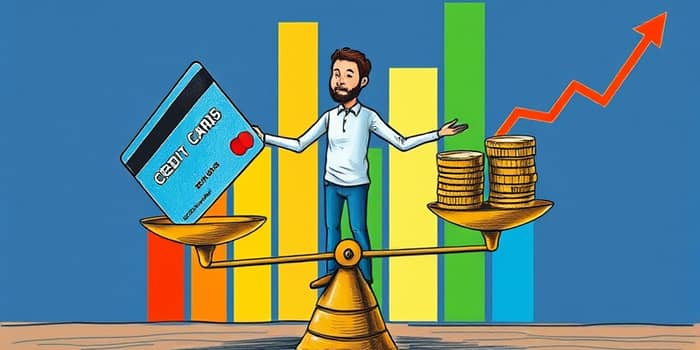Your credit score influences everything from loan approvals to interest rates and even your ability to rent an apartment. Yet many consumers overlook how much of your available credit truly shapes these decisions. By understanding credit utilization, you can unlock opportunities for better financing and long-term financial growth.
Consider Sarah, who paid her bills on time but routinely kept high balances until statement closing. Despite her perfect payment history, her score stagnated. A small shift—in this case, reducing reported balances—was enough to move her from fair to good credit territory within weeks.
Because credit bureaus calculate utilization each month, even a single high-balance statement can shave points off your score. Conversely, lowering balances strategically can yield dramatic improvements, often within a single billing cycle. This fluidity makes utilization one of the most accessible levers for consumers to influence their credit profile.
Why Credit Utilization Matters to Lenders
Lenders rely on utilization as a barometer of your financial habits. A high ratio indicates you may be stretching beyond your means, signaling potential difficulty in repaying future debts. Conversely, a consistently low ratio reflects sound repayment habits and lower borrowing risk, making you a more attractive applicant.
Mortgage and auto lenders, in particular, assess utilization closely to determine interest rates. A borrower with a utilization rate under 10% may qualify for significantly better rates, saving thousands over the life of a loan. Small adjustments can yield substantial long term savings on interest payments.
Furthermore, credit card issuers themselves review your utilization before offering higher lines of credit or promotional deals. Demonstrating responsible use by maintaining a low ratio can unlock new benefits and exclusive card offerings.
Calculating Your Credit Utilization
Determining your ratio involves two main steps. First, calculate per-card utilization:
- Calculating utilization on each card: Divide the current statement balance by the card’s credit limit. For instance, a $200 balance on a $1,000 limit equals 20% utilization.
- Calculating your overall utilization ratio: Sum all card balances, divide by the total of all credit limits, and multiply by 100. A combined $500 balance divided by $5,000 in total limits results in 10% utilization.
Keep in mind that credit bureaus capture balances on the statement closing date. To manage this, monitor due dates carefully and consider paying down balances before the closing cycle. Consistent tracking gives you control over what gets reported.
Some apps and online banking dashboards provide real-time updates on available credit and current balances. Utilizing these tools can help you avoid surprises and maintain desired utilization levels throughout the month.
Effects on Your Credit Score
Credit models assign substantial weight to utilization. In the FICO system, it accounts for 30% of your score, while VantageScore attributes 20% of its evaluation to this factor. The impact is immediate—adjustments to your balance can reflect in your score after the next reporting cycle.
Data shows that consumers with scores above 720 average between 7% and 10% utilization, while individuals below 580 frequently carry ratios above 75%. Exceeding 30% can trigger a decline, highlighting impact anywhere from twenty to thirty percent of your score calculation.
Even if you owe a modest amount, a very small limit can make your ratio appear high. For example, carrying a $100 balance on a $300 card yields 33% utilization, sufficient to cause a noticeable dip in your score.
Common Pitfalls and Misconceptions
- Closing unused accounts reduces total credit available, often raising your utilization ratio.
- Believing zero utilization guarantees the best score can backfire; no activity fails to demonstrate credit management.
- Focusing only on utilization without addressing payment history, account age, and credit mix provides an incomplete strategy.
Many consumers make small, incremental shifts—like letting balances creep up over time—only to be surprised by sudden score drops. Regularly reviewing your credit report can reveal unnoticed rises in utilization and allow prompt corrective action.
Another frequent mistake is charging significant purchases close to your card limit just before the statement date. Even if you pay in full later, the high balance at closing may already have been reported.
Strategies to Optimize Your Utilization
Implementing targeted strategies can lead to substantial improvements in your credit profile and score over time.
- Pay down balances before each statement closing to ensure lower reported utilization.
- Request a higher credit limit from your issuer without increasing your spending.
- Spread large purchases across multiple cards, avoiding maxing out any single account.
- Set up alerts or automated payments to tackle balances early in the billing cycle.
For those with limited credit history, consider secured cards or small personal loans to build a track record of low utilization and timely payments. Over time, transitioning to unsecured cards with higher limits can further boost your overall ratio.
Remember, the goal is consistent, balanced use of revolving credit accounts. Sporadic low utilization followed by spikes may raise red flags for underwriters evaluating your credit applications.
Monitoring and Reviewing Your Reports
Vigilance is key to maintaining healthy credit utilization. Obtain free annual credit reports from all three major bureaus and review your balances, limits, and any discrepancies. Flag any errors—such as misreported high balances—and dispute them promptly to prevent unjust score penalties.
Enrolling in credit monitoring services can alert you to sudden changes in your utilization or new hard inquiries. These timely notifications allow you to react quickly, whether that means paying down balances or investigating potential fraud.
In today’s digital age, many financial institutions offer dashboards that display real-time credit usage and available limits. Use these resources to track spending habits, set personal utilization targets, and cultivate habits that favor score growth.
Advanced Considerations and Model Trends
Next-generation scoring models, including FICO 10T and VantageScore 4.0, evaluate trended data rather than a single snapshot. They reward borrowers who demonstrate sustained low utilization and consistently pay down balances, offering a deeper view into financial discipline over months and years.
These models can identify patterns such as frequent balance oscillations, even if the overall ratio remains low. By recognizing long-term trends, scoring systems can differentiate between borrowers who dip into credit for planned expenses versus those who carry revolving debt habitually.
Keeping abreast of these evolving methodologies empowers you to fine-tune your credit habits. Prioritize early balance reductions, maintain steady utilization, and periodically reassess your approach as model criteria advance.
By mastering the dynamics of credit utilization and integrating proactive management techniques, you can protect and enhance your credit standing. Over time, these efforts pay dividends in better interest rates, higher lending limits, and greater financial freedom.
References
- https://www.experian.com/blogs/ask-experian/credit-education/score-basics/credit-utilization-rate/
- https://www.equifax.com/personal/education/debt-management/articles/-/learn/credit-utilization-ratio/
- https://www.creditkarma.com/credit/i/credit-card-utilization-and-your-credit-score
- https://www.cbsnews.com/news/how-credit-utilization-affects-your-credit-score-and-what-to-do-about-it/
- https://www.bankrate.com/credit-cards/advice/credit-utilization-ratio/
- https://www.firstmutualholding.com/resources/why-your-credit-utilization-ratio-matters/
- https://www.lendingtree.com/credit-repair/credit-utilization-ratio/
- https://www.experian.com/blogs/ask-experian/how-long-will-high-credit-utilization-hurt-credit-score/










